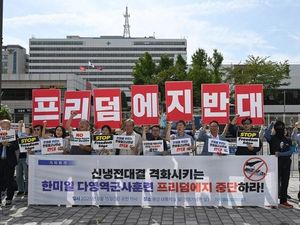Imagine a summer day bustling with vacationers eager to dive into warm weather adventures. Suddenly, an unwelcome visitor joins the party: a resurgence of COVID-19 cases, driven by new variants cropping up across the U.S. This wave is not just a ripple but a significant swell, sending more individuals to hospitals and prompting renewed concern nationwide.
This story unfolds with striking intensity in Los Angeles County, where recent data indicates a notable uptick in COVID infections, accompanied by somber tales of severe symptoms. Some individuals, many of whom previously experienced milder cases, now face debilitating bouts of illness. "It's kind of like playing COVID roulette," warns Dr. Peter Chin-Hong, an infectious diseases specialist at UC San Francisco. The unpredictable nature of the virus, even for those previously infected or vaccinated, is a stark reminder of its lingering threat.
Across the broader U.S., Centers for Disease Control and Prevention (CDC) data paints a concerning picture. COVID-related emergency room visits have surged, with a notable 23% rise. Hospital admissions and deaths tell a similar story. Hawaii stands out with a substantial increase in cases, though states like Arizona, New Mexico, Florida, and Washington aren’t far behind. The pattern is clear: the pandemic remains far from over.
A deeper dive into these numbers reveals the multifaceted reasons behind the spikes. For one, immunity from prior infections or vaccinations wanes over time. Then there’s the matter of evolving variants. The current culprits, collectively nicknamed FLiRT, include the subvariants KP.3, KP.2, and KP.1.1 – now dominant in many areas.
Each person’s immune response varies, and an interplay of factors determines the severity of symptoms. Anecdotal accounts, such as those on Reddit, reflect this range of experiences. One user laments, “I’ve had COVID a few times, but this is the worst. The recurring fever, sinus pressure, and sheer exhaustion – it’s taking me out.” Another vividly describes the sensation: “My throat feels like razor blades.” These narratives underscore the unpredictable nature of the virus and the intense discomfort it can cause.
Beyond personal stories, the scientific community offers data-backed explanations and remedies. Dr. Chin-Hong suggests that gaps between vaccinations and infections may lead to diminished "immune memory." As the virus mutates, the body’s previous defenses might not recognize the new threat immediately. He likens this to the surprise the immune system faces when encountering the current variants after a hiatus from boosters or infection. "It’s evolved so much, and the body is, like, ‘O-M-G, what is this thing that I’m seeing?’" he explains.
Such insights emphasize the importance of staying updated with vaccinations. Despite the low uptake of the latest vaccine, experts continue to advocate for getting the shot, particularly for high-risk groups such as seniors and the immunocompromised. The effectiveness of these vaccines remains high, especially in preventing severe outcomes like hospitalization and death.
The cyclical nature of COVID seems to echo the patterns of other respiratory viruses, showing peaks not just in winter but throughout the year. Factors like temperature, humidity, and human behavior, such as increased indoor activity during extreme weather, significantly influence its spread. CDC data highlights how the virus survives longer in colder conditions, contributing to increased cases during these periods. Furthermore, the emerging new variants and a general decline in immunity due to time lapses since the last vaccination or infection lead to these unpredictable surges.
A look at Hawaii’s recent trends reveals the virus's erratic behavior. While the state saw a rise in cases, CDC suggested that emergency room visits might plateau soon. Nevertheless, the fluctuating numbers are a stark reminder of the virus’s ongoing presence and potential for disruption.
One fascinating aspect of this resurgence is the notion of the "COVID bump," a phrase used to describe the summer spikes in cases. Medical professionals, like Dr. William Schaffner from Vanderbilt University School of Medicine, note that this seasonal bump follows a pattern – up in the summer, a dip in the fall, followed by another rise in winter. Such patterns guide public health strategies, informing recommendations on vaccinations and other preventive measures.
With all the gloom, there’s a silver lining: advancements in treatments and preventive measures. Medications like Paxlovid, remdesivir, and molnupiravir offer promising results in reducing severe cases and preventing hospitalizations. Additionally, new monoclonal antibody treatments approved by the FDA provide preventive options for the highly immunocompromised.
Yet, the simplest measures often bear repeating. Regular testing, even with limited at-home kits, can significantly curb the spread. Experts advise testing at the onset of symptoms or after known exposure and taking precautions like masking and isolating when necessary. These steps, coupled with updated vaccines, form the frontline defense against COVID-19's continued impact.
Ultimately, while COVID-19 may no longer be the formidable foe it once was, it remains a significant health concern. "We mustn’t get complacent," says Dr. Paul Jones from Johns Hopkins Medicine. This sentiment echoes across the medical community, urging continued vigilance and proactive health measures.
As we navigate this pandemic’s ever-evolving landscape, one thing remains clear: the battle against COVID-19 is ongoing. Staying informed, updated on vaccinations, and cautious in our daily interactions can help keep the virus at bay. And though the virus may not dominate headlines as it once did, its presence is a reminder of the delicate balance we must maintain – a balance between normalcy and necessary precaution.



